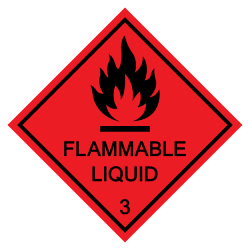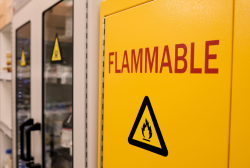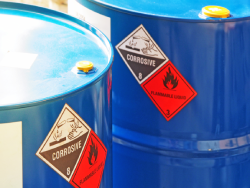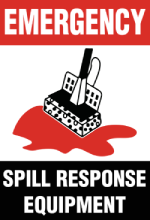Maintenance and Storage of Flammable Substances
Flammable substances are materials that can ignite easily or spontaneously combust and burn rapidly. They can be common materials that can be found at most work sites in gas, liquid, or solid forms. Some common flammable substances in the printing industry include cleaning solvents, isopropyl alcohol, various aerosol cans, propane tanks, oxygen tanks for welding combustible dust, ink and solvent contaminated rags or shop towels.
For a fire to occur, there needs to be three elements present: an oxidizer (most commonly oxygen), heat, and fuel. Take away one of these three components and a fire will not occur. Keep in mind that a heat source does not have to be an open flame. Heat can become present through a chemical reaction, sparks from an electrical current, static, etc.
Flammable Liquids
 When OSHA revised its Hazard Communication Standard in 2012, it changed the definition of flammable and combustible materials and now classifies all liquid materials capable of burning as flammable. Flammable liquids are subdivided into four categories,
which are based on flashpoint and boiling point.
When OSHA revised its Hazard Communication Standard in 2012, it changed the definition of flammable and combustible materials and now classifies all liquid materials capable of burning as flammable. Flammable liquids are subdivided into four categories,
which are based on flashpoint and boiling point.
A flash point is the lowest temperature at which its vapors ignite if given an ignition source. This information is also available in Section 9: Physical and chemical properties of the substances Safety Data Sheet (SDS).
A boiling point is the temperature at which the vapor pressure of a liquid equals the pressure surrounding the liquid and the liquid changes into a vapor. This information can also be found in Section 9 of your SDS.
The categories for flammable liquids are:
- Category 1. Liquids with a flashpoint below 73.4°F (23°C) and boiling point at or below 95°F (35°C).
- Category 2. Liquids with a flashpoint below 73.4°F (23°C) and boiling point at or above 95°F (35°C).
- Category 3. Liquids with a flashpoint between 73.4°F (23°C) and 140°F (60°C). When a Category 3 liquid with a flashpoint at or above 100°F (37.8°C) is heated for use to within 30°F (16.7°C) of its flash- point, it must be handled as a Category 3 liquid with a flashpoint below 100°F (37.8 °C).
- Category 4. Liquids having a flashpoint between 140°F (60°C) and 199.4°F (93°C). When a Category 4 flammable liquid is heated for use to within 30°F (16.7°C) of its flashpoint, it must be handled as a Category 3 liquid with a flashpoint at or above 100°F (37.8°C).
Requirements
Employers must develop procedures for the use and storage of these materials and train employees on these procedures to ensure safety in the workplace. Management procedures should address the following topics.
Storage
All storage containers used must be approved by the Department of Transportation. Portable containers must have a volume of 5  gallons or less, depending upon the classification of the material stored. All containers’ storage areas should be well- ventilated. Do
not store flammable materials near exits, electrical equipment, or heating equipment. Smoking is not permitted in or near storage areas
gallons or less, depending upon the classification of the material stored. All containers’ storage areas should be well- ventilated. Do
not store flammable materials near exits, electrical equipment, or heating equipment. Smoking is not permitted in or near storage areas
Ink and solvent-laden shop towels need to be kept in closed metal containers. The containers need to be maintained and any damaged ones replaced. PRINTING United Alliance provides information on the environmental regulatory issues for use, storage and disposal of solvent contaminated shop towels.
As a rule, keep on site only the amount of flammable material you need and keep containers closed when substance is not in use. OSHA has specific rules about the maximum amount of flammable liquid that can be stored outside of a solvent storage cabinet or solvent storage room. Maximum amounts are as follows:
- 25 gallons of Category 1 flammable liquids in containers
- 120 gallons of Category 2, 3, or 4 flammable liquids in containers
- 660 gallons of Category 2, 3, or 4 flammable liquids in a single portable tank
Transferring Materials
Special safety practices, such as grounding and bonding, must be utilized when transferring or dispensing flammable liquids. Moving liquid from one container to another can cause static electricity, increasing the chance of ignition or explosion caused by a spark. The purpose of bonding is to eliminate a difference in the static electrical charge potential between two or more objects. Grounding eliminates the potential difference between an object and the ground.
 OSHA’s
regulations require Category 1, 2, or 3 flammable liquids with a flashpoint below 100°F (37.8°C), will not be dispensed into containers unless the nozzle and container are electrically interconnected.
OSHA’s
regulations require Category 1, 2, or 3 flammable liquids with a flashpoint below 100°F (37.8°C), will not be dispensed into containers unless the nozzle and container are electrically interconnected.
For bonding and grounding to be effective, a metal-to-metal connection must be maintained between the bonding and grounding cables and the containers. To ensure a strong connection, all paint, dirt, rust, etc., must be removed from the area of connection.
Labeling
Containers holding flammable materials should include a warning label, including any potential hazards.
Spill Clean Up
If a spill occurs, clean it up immediately and dispose of whatever you used to clean it in its own receptacle. Never put waste containing flammable substances into a bin of unknown materials. Do not keep waste containing flammable materials in the workplace for long, either.
Incompatible Materials
Chemicals can usually be grouped into five main categories: flammable/combustible, acid, alkaline or basic, oxidizer and reactive. These groups are incompatible with each other and must be stored separately.
Protecting Workers
Use and maintain engineering controls in the workplace, such as ventilation, to mitigate flammable gas build up.
If engineering or administrative controls are not sufficient to reduce the potential for exposure, the employer must require appropriate protective equipment. This may include respirators, fire retardant clothing, gloves, or goggles. PRINTING United Alliance’s Personal Protective Equipment page includes more information on this topic.
*If your facility contains special circumstances (e.g. confined spaces, hot work), additional precautions and training may be required.
Combustible Dust
OSHA does not have a specific regulation covering combustible dust. However, they can and do reference the National Fire Protection Associations (NFPA) standards in General Duty Clause citations when they discover unsafe conditions. OSHA’s compliance directive on Combustible Dust uses a dust thickness of 5/32 of an inch over 5% of the horizontal surface area of a specific area as the basis for issuing a citation. 5/32 of an inch is about the thickness of the bottom of a metal paper clip.
Combustible dust is generated in some printing operations through the cutting, slitting, and binding of paper, collection of paper trim in cyclones and other similar systems, spray powder, and routers cutting wood and other substrates. Scrap paper and dust collection systems should be designed and constructed to meet NFPA’s 652: Standard on the Fundamentals of Combustible Dust and 654: Standard for the Prevention of Fire and Dust Explosions from the Manufacturing, Processing, and Handling of Combustible Particulate Solids standards. Demonstrating that your system meets the NFPA standards will help avoid fire and explosion as well as an OSHA citation.
PRINTING United Alliance’s OSHA Compliance Resource Center provides technical assistance and services designed to allow printing operations to manage compliance and stay informed. For more information on Fire Safety or PRINTING United Alliance’s EHS services in general, email govtaffairs@printing.org or call 888-385-3588.